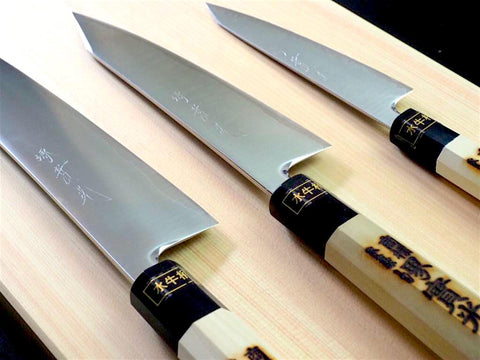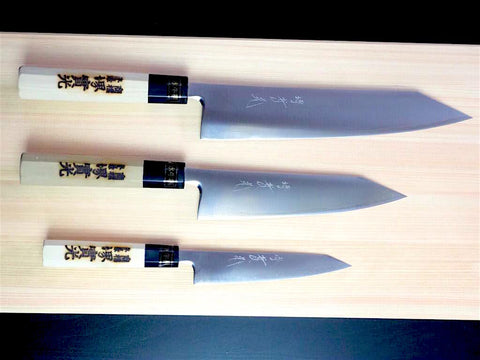- Home
- Kitchen Knives
- Sharpening Tools
- Outdoor knives
- Sharpening service & class
- More Japanese Crafts
- Home
- +Kitchen Knives
- +Sharpening Tools
- +Outdoor knives
- Sharpening service & class
- More Japanese Crafts
- Sign in

When it comes to cooking, having the right knife is crucial. In the culinary world, a good knife can make all the difference in the preparation and presentation of a dish. One of the biggest decisions you’ll need to make is choosing between Western and Japanese chef’s knives. Both are fantastic options, but there are some key differences to keep in mind regarding blade design, steel type and handle design. This blog post compares the differences, features and benefits of a Japanese and western chef knife to help you make the best choice for your specific needs.
Blade Design

Blade design is one of the most significant differences between Western and Japanese chef's knives. Japanese knives are typically lighter, thinner and sharper than their Western counterparts. They also have a straighter edge and more acute angle, allowing for more precise cuts. The thinner blade additionally makes it easier to slice through delicate ingredients like fish and vegetables. On the other hand, Western knives are generally heavier and have a thicker, curved blade. This design makes them ideal for heavier-duty tasks like chopping through bones and tougher meats. The curved blade also allows for a rocking motion, making it easier to chop herbs and vegetables.
Steel Type
The type of steel used is another difference between a Western and Japanese chef knife. Japanese knives are often made with harder steel, resulting in a sharper edge and longer-lasting blade. The downside of harder steel is that the blade can be more brittle and prone to chipping.
Western knives are typically made with softer steel that makes them more durable and resistant to chipping. While they may not hold their edge as long as Japanese knives, they’re usually easier to maintain and sharpen.
Handle Design

Another area in which Western and Japanese chef’s knives differ is the handle design. Japanese knives typically have a straight wooden handle, while Western knives often feature a curved handle with a bolster for added support. The straight handle on a Japanese knife allows for a comfortable grip, and the lack of a bolster means that the entire blade can be used for cutting. However, some people find the straight handle less secure than the curved handle of a Western knife.

Which Option is Best?
Ultimately, the choice between a Japanese and Western chef knife comes down to your personal preference and the type of cooking you’ll be doing. If you’re working with delicate ingredients and need precise cuts, a Japanese knife might be the best choice for you. If you need a knife for heavy-duty tasks and want something durable and easy to maintain, a Western knife may be preferable.
Invest in a Quality Chef’s Knife Today
No matter what knife you choose, investing in quality Western or Japanese chef’s knives can make a big difference in the quality of your cooking by saving time and improving technique. Browse the range of knives at Kaz’s Knife and Kitchenware today, or get in touch with our knowledgeable team for useful advice and recommendations.
